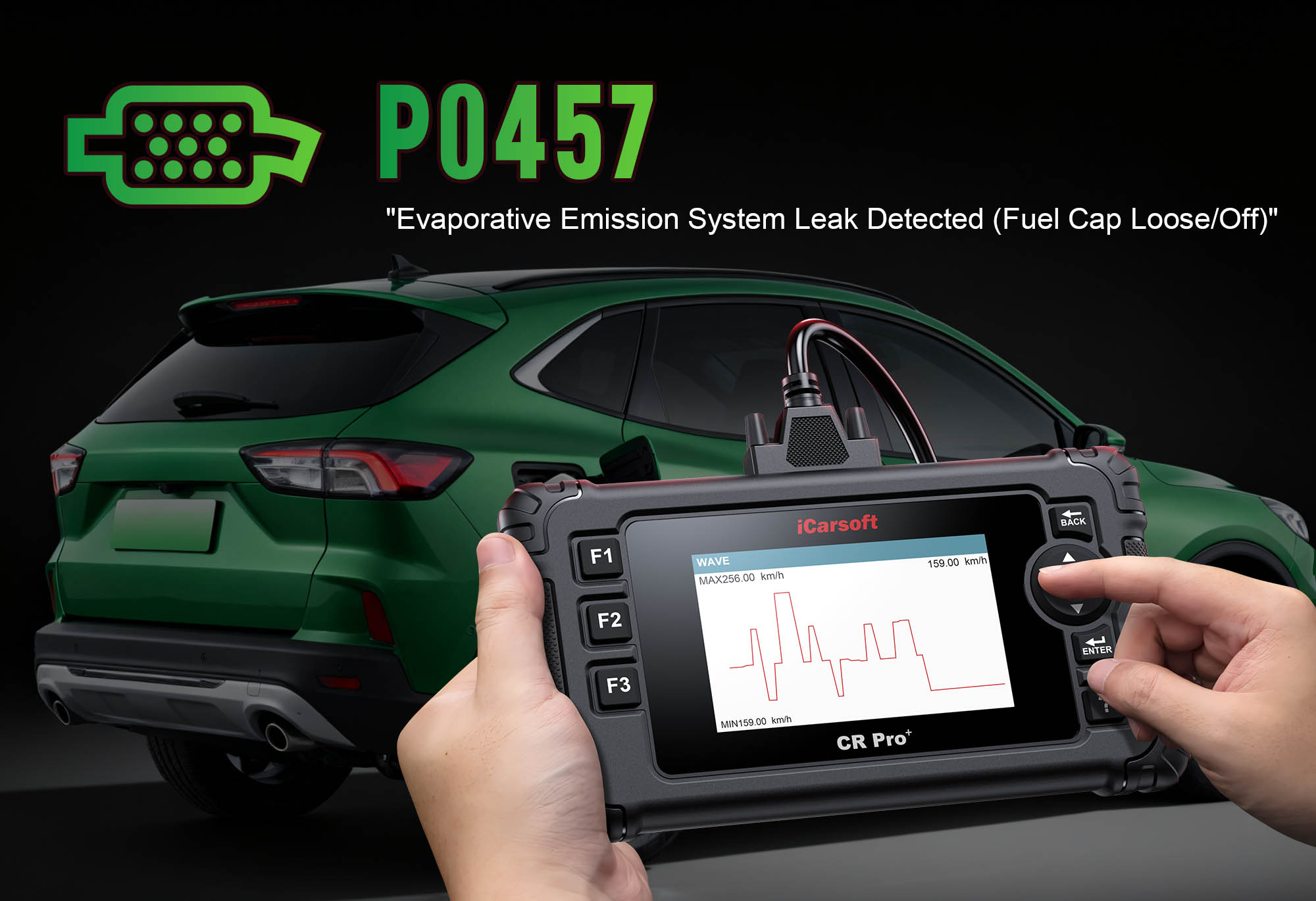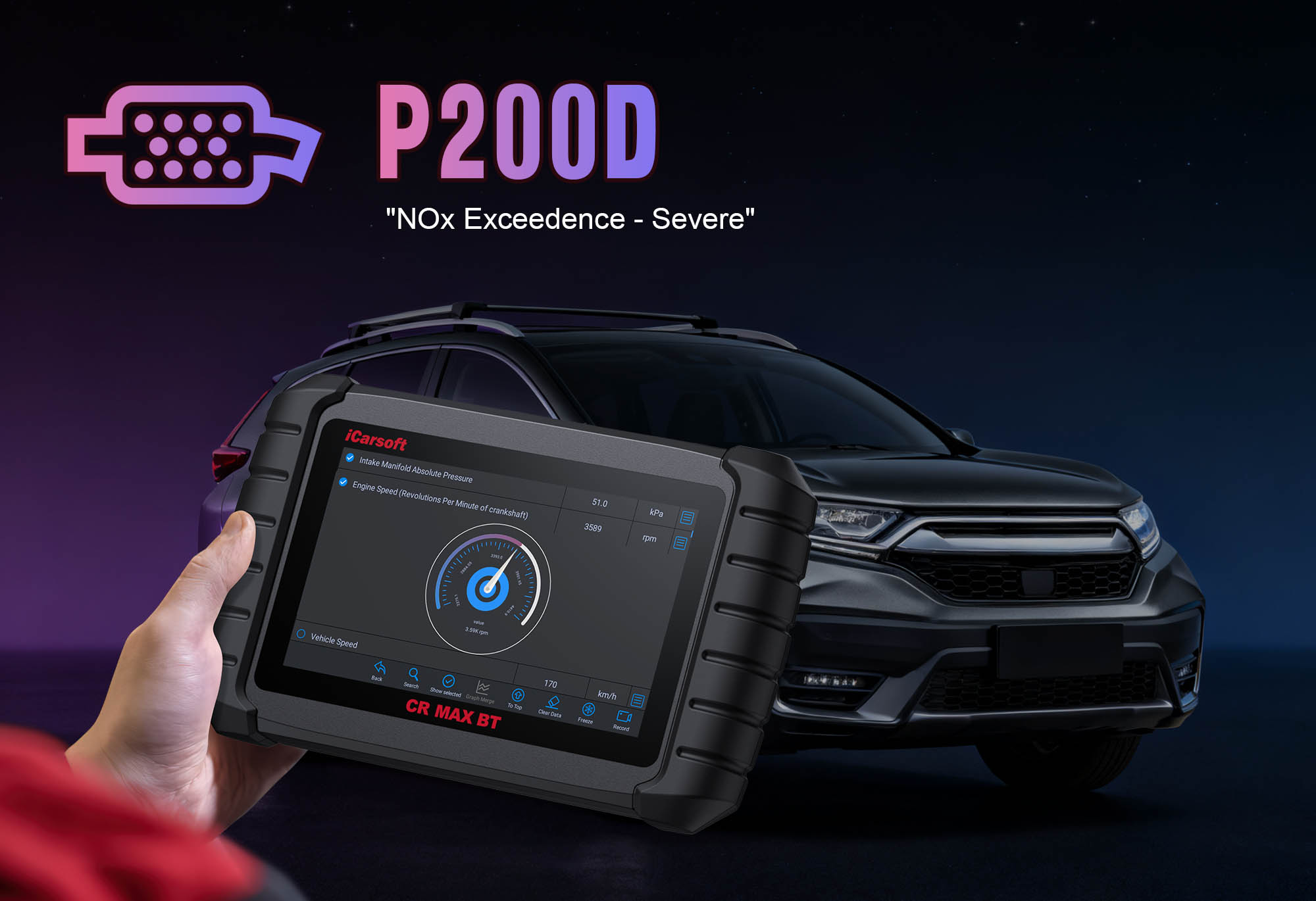Diagnose & Clear P0457 with iCarsoft CR Pro+: Fix EVAP System Small Leak Detected
If your check engine light illuminates and a scan returns P0457, your vehicle’s Evaporative Emissions (EVAP) system is signaling a small but critical 密封性 (seal) issue. This generic OBD-II code stands for "Evaporative Emission System Leak Detected (Small)"—meaning the Engine Control Module (ECM) has detected that fuel vapors are escaping from the EVAP system through a leak smaller than 0.04 inches (1mm), typically from loose, cracked, or worn components.
The EVAP system’s core role is to trap fuel vapors from the fuel tank and route them to the engine for combustion, preventing harmful emissions from entering the atmosphere. It relies on a network of hoses, valves (like the purge and vent solenoids), a charcoal canister, and a fuel tank pressure (FTP) sensor to maintain a tight seal. When P0457 occurs, even a tiny leak disrupts this seal—while it may not cause immediate performance issues, it leads to failed emissions tests and violates environmental regulations.
Basic scanners might only confirm "small EVAP leak" but can’t pinpoint the leak’s location or test component 密封性. The iCarsoft CR Pro+—with its dedicated EVAP leak detection tests, real-time FTP monitoring, and component activation tools—solves this. Let’s walk through how to diagnose and resolve P0457.
 iCarsoft CR Pro+ monitoring fuel tank pressure (FTP) to detect P0457 small leaks
iCarsoft CR Pro+ monitoring fuel tank pressure (FTP) to detect P0457 small leaks
Understanding P0457: Causes & Key Symptoms
To tackle P0457 effectively, first recognize how small EVAP leaks impact the system and your vehicle:
Key Symptoms of P0457
-
Check Engine Light: The most common indicator—illuminates when the ECM’s leak detection monitor (usually a "smoke test" or pressure decay test) identifies a small leak during driving or idle.
-
Fuel Odor (Faint): A subtle gasoline smell near the fuel tank or rear of the vehicle (vapors escaping through the leak).
-
Failed Emissions Tests: Even small leaks raise hydrocarbon (HC) emissions, causing test failures (critical for vehicle registration in most regions).
-
Intermittent Light: The check engine light may turn on/off if the leak is temporary (e.g., a loose gas cap that tightens slightly while driving).
-
Reduced Fuel Efficiency (Minor): In rare cases, severe small leaks can disrupt fuel vapor recycling, leading to 1–2% lower MPG.
Common Causes of P0457
|
Cause
|
Description
|
|
Loose or Damaged Gas Cap
|
The #1 cause—an improperly tightened cap (not twisted until 3–4 clicks) or a cracked cap seal allows vapors to escape (accounts for ~40% of P0457 cases).
|
|
Cracked EVAP Hoses
|
Small splits in hoses connecting the fuel tank to the charcoal canister (common in older vehicles due to heat, age, or rodent damage).
|
|
Worn Vent Solenoid Gasket
|
The vent solenoid (near the charcoal canister) has a degraded rubber gasket, creating a tiny gap for vapor leakage.
|
|
Leaking Fuel Tank Pressure (FTP) Sensor
|
A faulty FTP sensor’s O-ring or housing seal fails, allowing fuel vapors to seep out around the sensor.
|
|
Charcoal Canister Damage
|
Small cracks in the canister (from road debris, corrosion, or impact) break the EVAP system’s sealed network.
|
|
Loose Hose Clamps
|
Over time, clamps securing EVAP hoses to components loosen, creating small gaps for vapor escape.
|
Why iCarsoft CR Pro+ Excels at Diagnosing P0457
The CR Pro+ outperforms basic tools with features tailored to EVAP leak detection—critical for pinpointing P0457’s elusive root cause:
Dedicated EVAP Leak Detection Test
Runs dealership-grade pressure decay or smoke simulation tests, identifying leaks as small as 0.02 inches (0.5mm)—far more precise than basic scanners.
Real-Time Fuel Tank Pressure (FTP) Monitoring
Tracks FTP changes (normal = -2 to +2 psi) in real time—rapid pressure drops confirm small leaks even before the check engine light activates.
Component Activation Tests
Bi-directionally controls purge/vent solenoids to isolate leaks—e.g., closing the vent solenoid and monitoring pressure to determine leak location (upstream/downstream).
Vehicle-Specific EVAP Diagrams
Preloaded with color-coded schematics for 65+ makes (e.g., Toyota RAV4, Ford Escape, Honda CR-V), showing hose routes, component locations, and clamp positions.
Gas Cap Seal Test
Guides step-by-step cap inspection and pressure testing to rule out the most common P0457 cause in minutes—no guesswork.
Post-Repair Validation
Re-runs leak tests after fixes to confirm the EVAP system is fully sealed—ensures repairs resolve the root cause, not just mask symptoms.
Step-by-Step: Diagnose P0457 with iCarsoft CR Pro+
-
1. Connect & Confirm the Code
Plug the CR Pro+ into your vehicle’s OBD-II port (under the dashboard) and power it on.
Select your vehicle via Auto VIN Scan (reads your VIN in 2 seconds) or manual entry (make/model/year).
Navigate to Engine > Fault Codes > Read Codes to confirm P0457. Tap Code Details for vehicle-specific info (e.g., "Toyota: EVAP Leak <0.04in – Check Gas Cap & Rear Hoses").
-
2. Rule Out the Gas Cap First (Most Common Cause)
Start with the simplest, lowest-cost fix—use the CR Pro+ to validate the gas cap:
Visual Inspection: Remove the gas cap and check for cracks in the rubber seal, damaged threads, or debris (wipe the seal clean with a damp cloth).
CR Pro+ Gas Cap Test:
Navigate to Special Functions > EVAP System > Gas Cap Seal Test.
Follow on-screen prompts: Tighten the cap until you hear 3–4 clicks, then start the engine.
The scanner monitors FTP for 5 minutes—stable pressure = cap is good; pressure drop = faulty cap (replace with OEM cap for proper sealing).
-
3. Run the EVAP Leak Detection Test
Use the CR Pro+’s flagship test to locate the leak:
Ensure the fuel tank is 1/4 to 3/4 full (too full/empty skews pressure readings) and the engine is off.
Navigate to Special Functions > EVAP System > Leak Detection Test.
Select the test type (varies by vehicle):
- Pressure Decay Test: Scanner closes the vent solenoid, pressurizes the EVAP system to 2 psi, and monitors for loss. Drop >0.5 psi in 2 minutes = small leak.
- Smoke Simulation Test: Scanner sends a simulated "smoke signal" through the system; FTP sensor detects vapor escape points.
The test will indicate a leak zone (e.g., "Rear of Vehicle – Fuel Tank to Canister Hoses") to narrow your search.
-
4. Monitor Real-Time FTP Data
Track pressure changes to isolate the leak location:
Start the engine and let it idle for 2 minutes.
Navigate to Engine > Live Data > EVAP System and select "Fuel Tank Pressure (FTP)".
Observe pressure behavior:
- Normal: Fluctuates slightly between -1 and +1 psi.
- Leak Present: Pressure drops steadily (e.g., from +1 psi to -0.5 psi in 1 minute) as vapors escape.
Isolate with solenoid control:
Activate the vent solenoid via Special Functions > EVAP System > Vent Solenoid Control (select "Close").
- If pressure stabilizes: Leak is in the vent solenoid or charcoal canister (upstream of the closed valve).
- If pressure still drops: Leak is in the fuel tank, FTP sensor, or hoses downstream of the vent solenoid.
-
5. Inspect EVAP Components in the Leak Zone
Use the CR Pro+’s diagrams to check components in the identified zone:
Locate Components: Navigate to Component Location > EVAP System and select the leak zone (e.g., "Fuel Tank Hoses"). Scanner shows a 3D diagram of the area.
Check Hoses: Inspect for cracks, splits, or loose clamps (focus on hoses near the fuel tank—prone to road debris damage). Squeeze hoses gently—soft, brittle, or swollen hoses need replacement.
Test Vent/Purge Solenoids:
Navigate to Special Functions > EVAP System > Solenoid Activation.
Activate the vent solenoid—listen for a "click" (confirms it’s closing). No click or persistent pressure drop = faulty solenoid gasket (replace the solenoid).
Inspect FTP Sensor: Locate the sensor (usually on the fuel tank or EVAP hose) and check for oil/corrosion on the O-ring. Damaged O-ring = leak (replace the O-ring or sensor).
Check Charcoal Canister: Look for dents or cracks (common under the rear bumper). If damaged, replace the canister (ensure compatibility with your vehicle’s emissions system).
-
6. Repair the Leak
Fix the root cause based on diagnostics (guided by the CR Pro+):
- Loose/Damaged Gas Cap: Replace with a new OEM cap (use CR Pro+’s Part Lookup to find the correct part number—e.g., Toyota 77300-0C040).
- Cracked Hoses: Cut out the damaged section and replace with fuel-resistant EVAP hose (match inner diameter—scanner specifies size). Secure with new stainless-steel clamps.
- Faulty Solenoid/Gasket: Replace the vent solenoid (OEM recommended—e.g., Dorman 911-082) or just the gasket (if available).
- Leaking FTP Sensor: Replace the sensor’s O-ring (use high-temperature, fuel-resistant rubber) or the entire sensor (follow scanner’s torque specs for installation).
- Damaged Canister: Install a new canister (ensure it’s EPA-certified) and reconnect hoses per the CR Pro+’s diagram.
-
7. Clear the Code & Validate the Repair
Ensure the EVAP system is fully sealed to prevent P0457 recurrence:
Clear the Code: Navigate to Engine > Fault Codes > Clear Codes to delete P0457 and any related EVAP faults.
Run Post-Repair Test: Re-run the EVAP Leak Detection Test via the CR Pro+. The test should show "System Sealed – No Leaks Detected".
Test Drive: Take a 20-minute drive (include highway and city driving) to allow the ECM to complete its EVAP monitor cycle.
Re-Scan: Plug the CR Pro+ back in and run a fault code scan—no P0457 recurrence + stable FTP readings = successful repair.
Preventing P0457 Recurrence
The CR Pro+ helps maintain a tight EVAP system seal long-term:
-
Gas Cap Maintenance: Use the CR Pro+’s Service Reminder to check the gas cap every 3 months—tighten until 3–4 clicks, inspect the seal for cracks, and clean debris.
-
Hose Inspections: Schedule annual checks of EVAP hoses (via the scanner’s component diagrams) to catch cracks or loose clamps early.
-
Solenoid Tests: Run the Solenoid Activation Test every 15,000 miles to ensure vent/purge solenoids are sealing properly.
-
Fuel Tank Care: Avoid overfilling the tank (fuel can saturate the charcoal canister, leading to leaks) and clean the filler neck regularly.
-
Winter Protection: In cold climates, use the CR Pro+ to check for frozen EVAP hoses (ice can create temporary leaks)—thaw hoses before driving to prevent damage.
Conclusion
P0457’s small leak is easy to overlook but critical for emissions compliance—and the iCarsoft CR Pro+ turns guesswork into precision. With its dedicated leak tests, real-time pressure monitoring, and vehicle-specific guides, it eliminates the frustration of chasing tiny EVAP leaks that basic scanners miss.
Whether you’re replacing a gas cap, fixing a cracked hose, or swapping a solenoid, the CR Pro+ ensures you seal the system correctly. With this guide, you’ll turn a "small EVAP leak" into a quick, confident repair—keeping your vehicle emissions-compliant, avoiding test failures, and protecting the environment, one tight seal at a time.
FAQs About P0457 Code
Q: Can I drive my vehicle with P0457?
A: Yes—P0457 is not an immediate safety hazard. However, it will cause failed emissions tests, and prolonged leaks can damage the charcoal canister (costing $200–$500 to replace). Fix it within 1–2 months to avoid larger issues.
Q: Why does P0457 come and go?
A: Intermittent P0457 usually stems from temporary leaks—e.g., a gas cap that loosens slightly over time, or a small hose crack that expands/contracts with temperature (worse in cold weather). The CR Pro+’s pressure monitoring catches these even when the code isn’t active.
Q: How much does it cost to fix P0457?
A: Costs are low for most fixes: Gas cap = $15–$40 (DIY); EVAP hose/clamps = $10–$30 (DIY); solenoid = $40–$120 (DIY); FTP sensor = $50–$150 (DIY); charcoal canister = $200–$500 (professional). Professional labor adds $100–$200—save by diagnosing with the CR Pro+ first.
Q: Will a "smoke machine" work better than the CR Pro+ for P0457?
A: The CR Pro+’s smoke simulation test is comparable to basic smoke machines—plus it adds real-time FTP monitoring and component activation to isolate leaks faster. For home mechanics, the CR Pro+ eliminates the need to buy/rent a separate smoke machine.

 iCarsoft CR Pro+ monitoring fuel tank pressure (FTP) to detect P0457 small leaks
iCarsoft CR Pro+ monitoring fuel tank pressure (FTP) to detect P0457 small leaks



